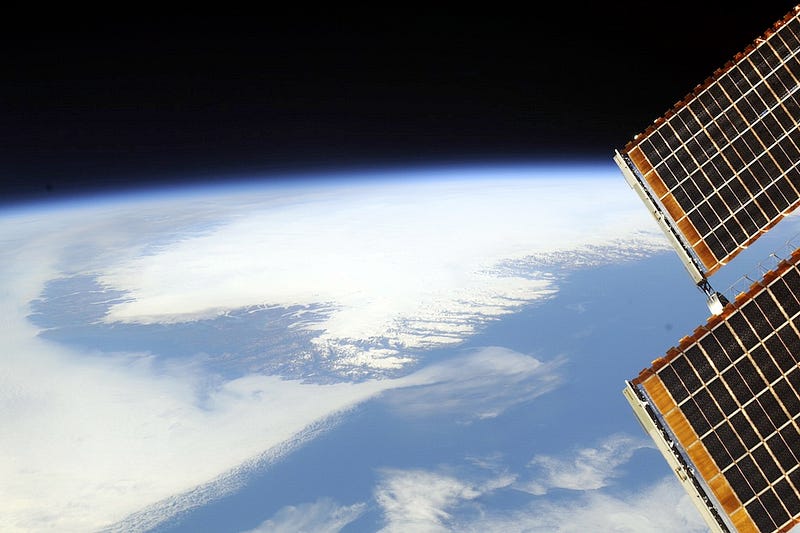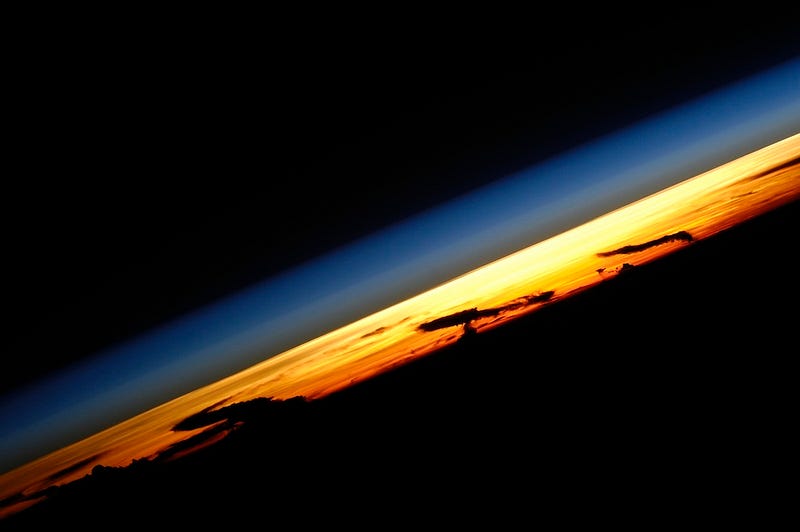Throwback Thursday: Discovering the Earth from Space
The top 10 pictures from a Russian cosmonaut you’ve never heard of.
Image credit: NASA, Space Shuttle Atlantis, during mission STS-132.
“We came all this way to explore the Moon, and the most important thing is that we discovered the Earth.” –Bill Anders, Apollo 8 astronaut
From hundreds of miles up, the International Space Station speeds around the Earth, completing 18 orbits a day, looking down on us and returning some absolutely fabulous images.

But what you may not appreciate is that my favorite images taken from space weren’t taken by American Astronaut Don Pettit (better known as @astro_Pettit), nor by famed Canadian Chris Hadfield nor by the amazing Karen Nyberg.
You see, every astronaut aboard the International Space Station has the opportunity to experience our world from a vantage point some 300 miles (500 km) above it, taking in sights that are alien to all but a few of us. But some people have gotten incredibly creative, and captured some wonders — both natural an artificial — that far exceed anything our imaginations could have cooked up. And on that account, my favorite set of pictures comes from a Russian Cosmonaut, Fyodor Yurchikhin, who’s one of the most prolific humans in spaceflight history.

Having spent a total of 370 days in space (which is somehow just 26th most, all-time), he’s performed five spacewalks, served as commander of the 196-day-long Expedition 15, and has been awarded the following accolades: the Order of Friendship, the NASA Space Flight Medal, and the Hero of the Russian Federation.
But what’s much more amazing — to me, and quite possibly, to all of you — is the pictures that he’s given us of Earth. I present to you my top 10 list of Fyodor Yurchikhin’s photos of Earth, from the International Space Station!

10.) A wide-angle shot of the Earth, along with the solar panels that power the ISS. The curvature of the Earth, the distant limb of the atmosphere, high-altitude clouds and their long shadows are all visible here, looking over the blue ocean of our world. What I love most about it is how striking the differences are between the clouds and their shadows, showing how huge a difference just a few miles (or kilometers) can make, and how that difference all but disappears as you head towards the horizon.
Wide-angle shots like these are often spectacular, but from the ISS, we have the ability to look down and obtain incredibly high-resolution, bird’s-eye-view photos of some of the most amazing sights on Earth!

9.) Like the series of dormant and active volcanoes of Kamchatka, in Russia. The volcanic ash from the erupting peak blackens the snow atop not only the erupting mountain, but also its nearest neighbors. What’s also amazing to me is that you can even tell what direction the wind blows, from space, just by following the trail of ash, smoke and soot.

8.) Any idea what this is? I’ll give you a hint: there’s only one river in the world that meanders over great distances like this through a rainforest.
Did you guess the Amazon? Well, I did, too, and we’re only kind of right.
As it turns out, this is definitely a part of the great Amazon river basin, but not the major flow of the river itself. Further research shows that it’s most likely one of the Amazon’s tributaries, considering that there are over 1,100 major tributaries, dozens of which are over 1,000 kilometers in length!

7.) Where else, but in low-Earth orbit, can you go from flying over a tropical rainforest to, just minutes later, flying over terrain like this?
If you’re a fan of glaciers, Yurchikhin has you covered! The Patagonian glaciers of South America are sadly among the fastest melting in the world, but their beauty is undeniable, and Fyodor’s shot from the ISS captures it in a way that no terrestrial shot ever can.

6.) Does this photo remind you of Van Gogh’s Starry Night? I figured this skyscape would, but unbelievably, this is a natural feature that appears regularly on Earth! These are whorling clouds that form on the boundary between two regions of air moving over the ocean at different relative speeds.
You may be more familiar with formations like this on gas giant planets, but Earth has them too, just on a much smaller scale, and that’s what you’re seeing here.

5.) What’s that spacecraft silhouetted against a background of stars? It’s a shot of the night sky that you’ve never experienced before! While this may look like a voyage to the stars, it’s actually the opposite: an unmanned Progress spacecraft — the ISS gets three to four of them a year to replenish vital supplies to their crew — leaving the space station after a successful resupply.
The same shape, size and design as the human-carrying Soyuz, this capsule was gently let go back towards our planet, where friction with the Earth’s atmosphere eventually caused it to fall and burn up during re-entry. It’s very important to remove these spacecraft from orbit, otherwise they can collide with active missions, as famously happened in 1997 when a Progress spacecraft struck Mir!

4.) This exquisitve photo took me a bit of help to identify (thanks to The Bobs), but what you’re looking at is a lake from the south of the Tibetan Plateau, with the following Lat/Lon coordinates: 29.802369N 86.951294E. As striking as the bright blue color of the major lake is, and as beautiful as the rocky features surrounding it are, aren’t you a little curious about the colors you’re seeing?
In particular, why is the smaller lake, to the left, a different hue? Almost certainly, this smaller lake is very shallow, and probably full of either algae or volcanic minerals at the bottom. At very low depths, the coloration of the floor of lakes like these can often change the appearance of the water when viewed from above. If you want another piece of evidence that supports this idea, check out the large lake exhibiting this same effect (to a lesser extent) on the lower left rim, or the Emerald Lakes of New Zealand.
Hang on, because things are about to get really spectacular!

3.) Is this a human-caused feature? A quarry of some sort? Or maybe an impact crater, from a long-ago asteroid strike?
No; it’s the Richat Structure from the Sahara Desert!
An old, hardened volcano dome that gradually eroded over hundreds of millions of years, the rocks of the central region date to Pre-Cambrian times, with the outermost layers “only” some 400 million years old. For contrast, the sand dunes on either side shift their appearance in a matter of only a few days.

2.) Did the Superman logo just meet a watery grave? Unlikely; this ring-like structure in the middle of the ocean is known as an Atoll, where a fringing coral reef forms around a volcanic island over 100,000 years or more, and then the island itself completely erodes away over tens of millions of years! The resulting rim of coral, poking above the ocean’s surface and enclosing a watery lake, is one of nature’s most spectacular sights. This particular one is Atafu atoll, from the New Zealand territory of Tokelau. And finally…

1.) Illuminated by the Sun as the ISS approaches the day-side of the Earth, this photo — my favorite — shows the limb of the Earth, the transition between space and the upper atmosphere, the cloudy reflections of sunlight, and, in black shadows, activity on our world that could either be volcanic eruptions or human-caused pollution; it’s difficult to tell from this angle. It’s a rainbow-esque phenomenon, only visible under the right conditions, to someone external to our own world.
What’s maybe more amazing is that Yurchikhin isn’t a trained photographer at all, but a humble mechanical engineer who simply brought a camera along for the ride. I hope you enjoyed this spectacular tour of Earth and some terrestrial sights as they can only be viewed from out-of-this-world!
Leave your comments on the Starts With A Bang forum at Scienceblogs!





